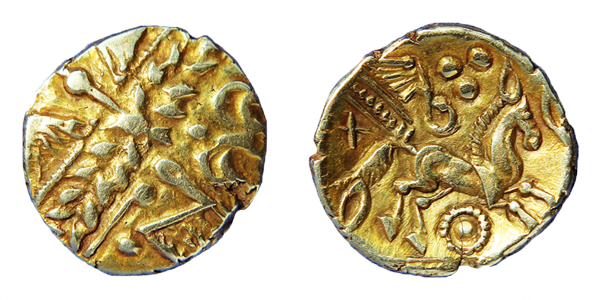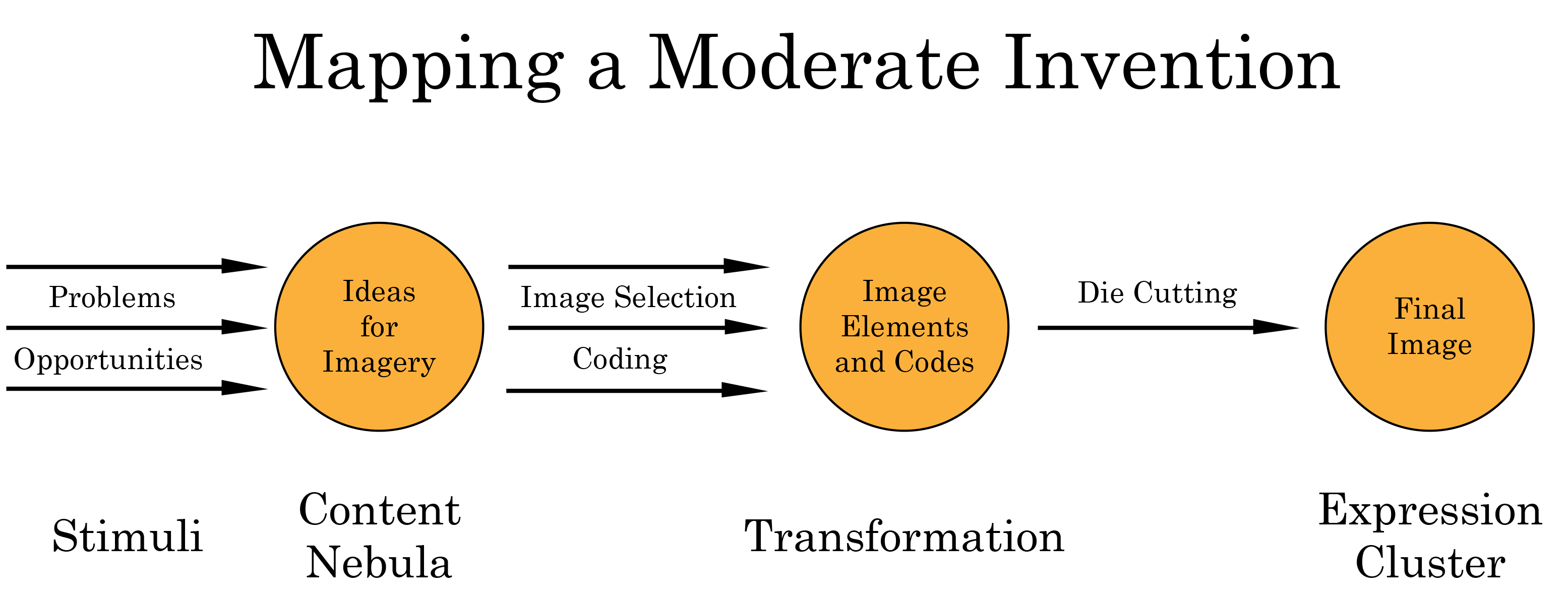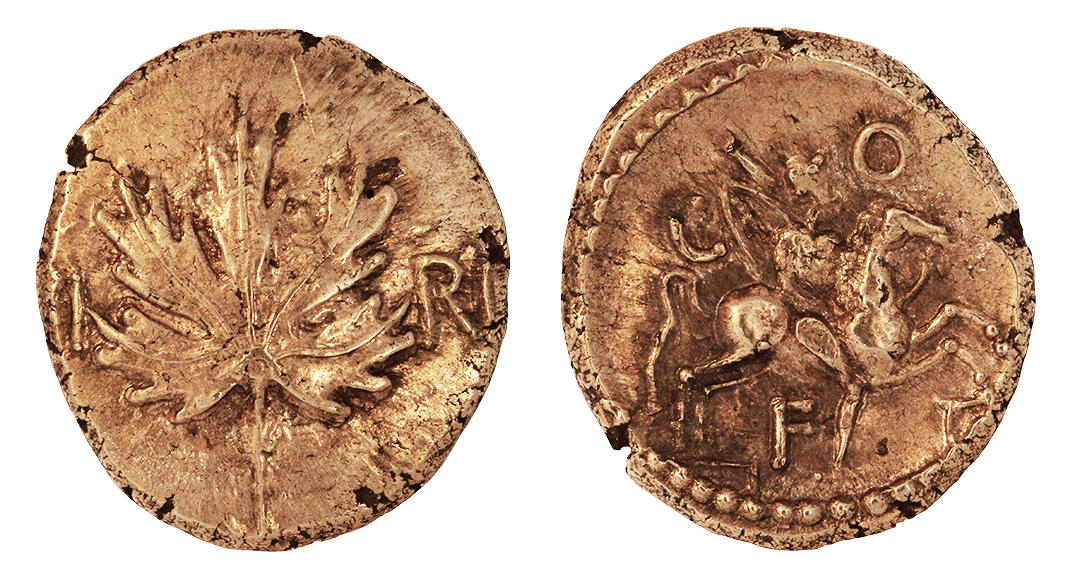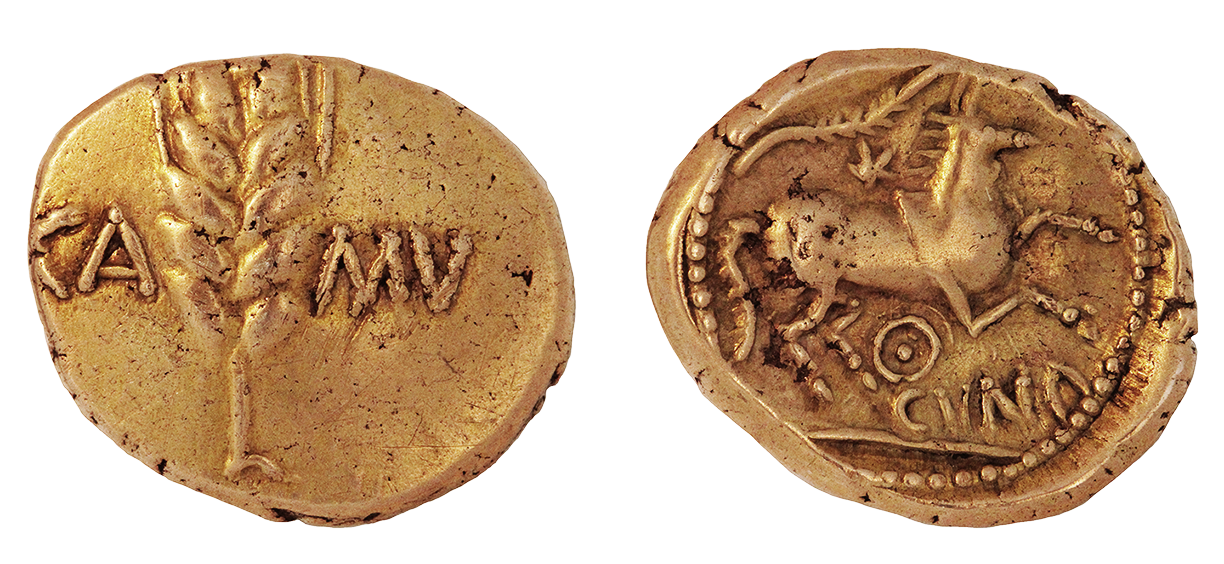
Numismatic Articles
Van Arsdell 2019a (Info)
Semiotics of Celtic Coins XIV – Mapping Inventions
By Robert D. Van Arsdell
Introduction
Mapping Inventions gives us much more analytical power than was the case for Replicas. Replicas are mere copies or adaptations of well known symbols. Inventions, however, are complex images that are created to deal with complex problems in the real world.
Mapping an Invention splits the creative process into two steps:
- The formulation of the problem in the mind of the ruler and the ruler's intended response.
- The creation of images to carry coded messages from the ruler to the people.
This split lets us analyze the ruler's situation and thought processes separately from the creation of the coin image. If we combine these two steps, we run the risk of dealing with a hopeless muddle of historical circumstances, cultural considerations, the ruler's hopes, desires and fears, the coding of the messages and the appearance of the final images. The split forces us to consider how the ruler was reacting to a situation separately from the issues surrounding the meaning of the imagery. By separating these two, we can assess the kinds of things a ruler hoped to accomplish and how well the ruler succeeded in attaining those goals.
Before we can begin to map Inventions, we need to discuss some concepts used to map them.
1) Kinds of Inventions
Two kinds of Inventions are mentioned by Umberto Eco. Only one of these is commonly encountered in Celtic numismatics. (Info)
Moderate Inventions
Moderate Inventions are those produced by the process outlined above. A ruler is faced with problems that can be solved by sending messages to the people. The first step is to clarify, as best as possible, those problems and the messages to be sent. Then, imagery is produced to code and transmit the messages to the people.
Radical Inventions
Radical Inventions are something completely different. The order of creation is reversed. First, imagery is created and then someone figures out what it "means". (Info)
Radical Inventions are most commonly seen in fine artwork. A painter may lay a canvas on the floor and then drip and splash paint on it. The resulting artwork is anything but representational. The artist, at the point of creation, may have no idea that it "means" anything at all. No semiosis has occurred – no code has been created that would link the image to a meaning.
The artist likely has a canny gallery owner who knows it's easier to sell artwork if some "meaning" can be offered to customers. A discussion may occur about the artist's state of mind – perhaps an argument with a neighbour, or a partner has run off with someone new. The painting may then come to represent "the difficulties of life", or "the ephemeral nature of human relationships". Semiosis occurred only at the point the gallery-owner coded the meaning.
Which kind of Invention do we encounter in practice?
It should be obvious that rulers would take care that their coins would convey suitable messages to the people. Rulers would be expected to give considerable thought to the imagery and the coded messages. This care would dictate that Moderate Invention would be the way forward.
But archaeologist Caroline Pudney, in a pair of thoughtful articles, has suggested that Radical Invention may have occurred. In these articles she explores social aspects of Dobunnic life and suggests how it may have influenced the semiotics of Dobunnic coinage. (Info)
It's entirely plausible that Pudney is right and Radical Invention may have occurred at times. One can imagine at least two situations where it may have happened:
- The unlikely case where the ruler and the die-cutter were the same person. Here, the ruler may have gone straight to die cutting and produced the desired imagery without an elaborate process of assessment and code-making. Semiosis occurred at the instant of creation.
- The case where the ruler simply instructed the die-cutters: "Go create something that makes me look good!". In this case, the die-cutters created something to please the ruler. Semiosis would have occurred when the ruler viewed the imagery and decided what it "meant".
It's certain that cases like these will be difficult to identify in practice. Demonstrating they are examples of Radical Invention will be harder. Nonetheless, it should always be kept in mind that Radical Invention is possible.
Most of the time, however, Moderate Invention is the more likely explanation. The following discussion focuses on Moderate Invention.
2) Elements of the "split"
Eco uses two ideas to "split" the creative process. He describes the kinds of things that happen in each step. (Info)
Content Nebulas
The first step is the creation of something Eco calls a "Content Nebula". It's expected to be a ragbag of half-finished ideas, problems to be solved and hopes a ruler may have. The ruler receives information in many forms, and comes up with possible things to do. Eco calls the incoming information "Stimuli".
Examples of Stimuli:
- Perceived threats from enemies and rivals
- Cultural knowledge – what people know and how they react
- Pre-existing symbols (gods and goddesses, images, etc.)
- Stories, tales, metaphors in common use
- Opportunities the ruler may perceive
- The aspirations and complaints of different groups in society
- The ruler's economic and political situation
- Alliances and agreements with subjects and foreigners
After assessing the Stimuli, the ruler will have some idea of things to do – and messages to give to the people. Those messages become the content used to create the coin imagery. One can easily see why Eco calls this a nebula. The information the ruler receives will be incomplete, equivocal and contradictory. As a result, the ruler probably will have an ill-formed idea of how to go forward.
Expression Clusters
The second step is creation of coin images that convey the desired messages to the people. On Celtic coins, the images are truly "clusters". There are a multitude of image devices and minor field objects. Some have specific meanings and those meanings may combine to produce secondary meanings (Amalgamation Switches).
Eco calls the process linking the Content Nebula with a suitable Expression Cluster one of "transformation". The nebulous ideas get firmed up into exact messages, imagery is created and the meanings coded. Semiosis occurs during the transformation. We are now ready to map Moderate Inventions.
Mapping Moderate Inventions
Eco provides a generalized diagram for mapping Moderate Inventions. (Info) It was designed to handle all kinds of expressions: images, texts, gestures, music, etc.
For Celtic coin imagery, we need something more specific. The following diagram adds Eco's concepts of the Content Nebula and Expression Cluster to re-label his diagram. The re-labeled diagram focuses attention on the acts of image creation from start to finish.

When mapping Replicas in an earlier article in this series, I simply reversed the mapping to analyze them. (Info) Nothing of the sort happens with Moderate Inventions. The mapping is more complex and the analysis is understandably more difficult.
Here, the nature of the Content Nebula is analyzed separately from that of the Expression Cluster. This can be done in any order. The Expression Cluster is analyzed to create a plausible Sememe Diagram for the coin image. (Info) The Content Nebula is analysed to find likely stimuli and flesh out a plausible set of ideas for the imagery.
In the previous article in this series, I identified nine steps for analyzing a Moderate Invention. (Info) The first eight steps created the Sememe Diagram for the Expression Cluster:
- Identify the image as an Invention (and not a Replica)
- Analyzing the image
- Create an "Inventory of Objects"
- Search for Codes
- Search for Amalgamation Switches
- Search for the use of Circumstance Selectors
- Search for metaphors
- Construct Sememe Diagram
The ninth and final step enumerates the stimuli a ruler may have received, and hypothesizes the ideas the ruler may have had as a result. It creates the Content Nebula.
9. Search for archaeological or documentary justification
Having created plausible Content Nebulas and Expression Clusters independently, the two are compared to see if the Transformation that connects them is plausible, as well. If everything is plausible, then we have created a plausible "meaning" for the image – one that will hold up under considerable scrutiny.
Although the ninth step seems simple compared to the first eight, it's actually not. As a starting point, you need to survey the ancient written sources for plausible stimuli. Then you have to find the rest of them in the archaeological literature.
Let's revisit an old example from Hawkes and Stevens to demonstrate how this works. (Info)
In 1951, C.E. Stevens made a suggestion about the images on two British staters. C.F.C. Hawkes expanded on Stevens' idea. Together, they speculated the vine leaf on a Verica stater said "wine is best" and was a metaphor for a pro-Roman stance. On the other hand, the barley ear on a Cunobeline stater said "beer is best" and was a metaphor for an anti-Roman one. Together, the two coins revealed a competition between the two rulers.
This interpretation has always been considered very clever. But the idea – completely unprovable – slowly faded into numismatic history. At first, Frere mentioned the beer vs. wine idea in the first edition of his Britannia. (Info) Frere had to distance himself from Steven's and Hawkes' overcoding, and also point out that there really wasn't any firm evidence that Cunobeline was anti-Roman. Nevertheless, he retained the mention through all three editions of Britannia. He appears to be the last author using the idea, later ones fail to mention it at all.
One wonders whether either of the original authors had further thoughts after 1951. It appears not. Hawkes annotated his personal copy of Stevens' article heavily with more information: literature sources, questions about dates, indications of agreement and disagreement, etc. But concerning the passage about beer vs. wine: he's silent. In his copy of the third edition of Frere's Britannia, Hawkes made a √ mark in the margin, perhaps either liking the idea that Frere had still included the mention, or accepting Frere's limitations. (Info)
Eco wouldn't publish A Theory of Semiotics for another 25 years, to provide the tools for assessing the beer vs. wine idea. The progress of archaeology since 1951 has added details for a fresh look.
In an earlier article in this series, I questioned whether Hawkes and Stevens had overcoded the meaning of the images improperly. (Info) Now, I'll elaborate on this.
It would be simplistic to declare the vine leaf and barley ear personal emblems of the two rulers – that they are Replicas (and dangerous to overcode). (Info) The barley ear is a recurring theme on Cunobeline's gold and so it may have been a personal emblem. But the vine leaf only occurs on one issue of Verica's coins and is thus less likely to be one. (Info)
On the whole, I think the images on these coins are Moderate Inventions. There are combinations of legends and image devices on each side of the coins. The obverse and reverse probably combine to produce Amalgamation Switches. (Info) They are complex images, not simple Replicas.
It's best to declare them Moderate Inventions and undertake the more complex analysis.
First, let's deal with the two Expression Clusters, because they're simpler to analyze and less controversial. Looking at Hawkes' and Stevens' writings we could produce sememes for the images like these:
For the Verica stater:

The obverse image would give a First Denotation of "vine leaf" with connotations of "wine is best" and "pro-Roman attitude". The reverse image would give a First Denotation of "warrior on horse" with a connotation of "the ruler is protecting the people". The two sides would combine via an Amalgamation Switch to give a Second Denotation of "effective ruler" with connotations of "the ruler's pro-Roman attitude is protecting the realm" and "the ruler will fight against anti-Roman influences".
For the Cunobeline stater:

The obverse image would give a First Denotation of "barley ear" with connotations of "beer is best" and "anti-Roman attitude". The reverse image would give First Denotations of "spirited horse" and "wreath" with connotations of "the ruler is invoking a goddess to protect the people" and "the ruler is creating peace in the realm". The two sides would combine via an Amalgamation Switch to give a Second Denotation of "effective ruler" with connotations of "the ruler's anti-Roman attitude is protecting the realm" and "the ruler will fight against pro-Roman influences".
Frankly, these sememes are perfectly plausible – it was, after all, a clever piece of interpretation. But the problems aren't in the Expression Clusters – they're in the Content Nebulae and Transformations.
The Content Nebulae
Stevens didn't propose any Stimuli or a Content Nebulae in 1951 (these concepts wouldn't be developed until the 1970s). However, it's possible to construct the elements he was using. The story actually starts with Brooke in 1933, in two papers on the ancient British coinage. (Info) These mapped out the territories of the British tribes, providing some Stimuli from the numismatics.
In 1936, Collingwood wrote a narrative for the period between the Caesarean and Claudian invasions, using Brooke's work and adding additional Stimuli from the writings of the ancient authors. (Info) Allen then expanded and refined the Stimuli from the numismatics in 1944. (Info)
Stevens finally built on all this earlier work and wrote his 1951 article. He added more Stimuli from the ancient authors, added some archaeological ones and refined (what we would call today) the Content Nebulae. At some point, Stevens conferred with Hawkes, who suggested a refinement to the numismatic interpretations.
The Stimuli:
- Tincomarus, Dubnovellaunus and Verica deposed (ancient authors)
- Tribal invasion in the South Thames region (numismatic evidence – Epaticcus)
- Support for Verica amongst the Romans via wine trade concesssions (archaeological finds – amphorae south of the Thames)
- Roman disenchantment with Cunobeline (numismatic evidence – Epaticcus)
- Possibilty of a Roman invasion throughout the period (ancient authors)
The Content Nebulae:
- Political instability in Britain.
- Conflict between Cunobeline and Verica
- Need to be prepared for a Roman invasion (presumably aiding Verica)
- Need to rally the support of the people
The Transformations:
- For Verica: coin imagery that suggests his pro-Roman stance will benefit the people (vine leaf denotes wine, connotes pro-Roman stance)
- For Cunobeline: coin imagery that ignites anti-Roman sentiment and rallies the people behind Cunobeline (barley ear denotes beer, connotes anti-Roman stance)
So what's wrong here?
Simply put, the Stimuli don't support the idea that Cunobeline and the issuing authorities of the North Thames region were staunchly anti-Roman. There isn't sufficient evidence to suggest people north of the Thames abhorred everything Rome had to offer. Consequently, a Content Nebula that has Cunobeline rallying his people around an anti-Roman stance is implausible and the Transformation to a "beer is best" metaphor is implausible, as well.
Part of the problem in 1951 was that one had to ignore or selectively interpret several Stimuli that should have been taken into account to construct the Content Nebula.
The first is that substantial numbers of wine amphorae had already been found north of the Thames. (Info) Consequently, the idea that Verica had some sort of "edge" over Cunobeline regarding wine isn't plausible.
Secondly, there are historical mentions of cooperation between British rulers and the Romans. Some of these likely involve rulers north of the Thames and others could apply to either north or south Thames rulers. (Info) This additional information weakens the idea that Cunobeline was staunchly anti-Roman.
Thirdly, Cunobeline's silver and bronze coinages do not suggest an anti-Roman stance in the choice of imagery. Fourteen types use images adapted from Roman denarii and at least seven additional types carry Romanized imagery. (Info) The issuing authorities north of the Thames were well-aquainted with Roman images and were not adverse to placing them on their coins. The argument that Cunobeline was anti-Roman is weakened by his choice of coin motifs.
Since 1951, new wine amphorae evidence makes us increasingly certain that wine was in use north of the Thames. Broken wine amphorae appear in rich graves in the Colchester and Verulamium regions. (Info) This suggests that rather than avoiding wine, Cunobeline's wealthy supporters were using it for ceremonial occasions.
Overall, though the evidence and interpretation of amphora finds are complicated, the region north of the Thames has an equal claim to the "wine is best" metaphor. (Info)
Thus, the beer vs. wine idea can be judged implausible. The Content Nebulae don't really make sense given the likely Stimuli. Thus, the two rulers probably did not select their images in this way. The images probably mean something else. (Info)
It's worth emphasizing that Eco's concept of analyzing the Content Nebula and the Expression Cluster separately could have solved the problems of semiotic interpretation here. Focussing on the creation of the Content Nebula, without thinking about the final imagery makes one search for all the Stimuli in a diligent manner. Constructing a plausible Content Nebula and a plausible Transformation, makes a mismatch with the Expression Cluster all the starker. It forces one to resolve the interpretation issues.
If one lumps Eco's two steps together in one grand analysis, there is little hope of spotting the incongruities.
End
